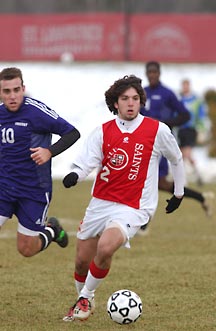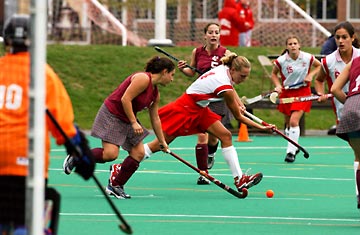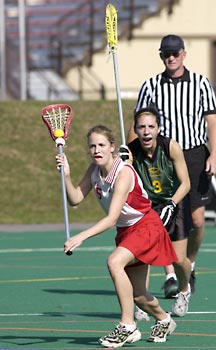Table of Contents
Do Colleges and Universities in America Have Intercollegiate Athletics Right?
One of the most successful college sports teams in the country recently, with a record of 118-8-7 over the last six seasons, men's soccer has played most of its home games in that span on MacAllaster Field, a product of Campaign St. Lawrence. Concerns about how athletics fits within the overall mission of the University and about the increasing specialization of young competitors permeated the discussions of a group of more than 30 concerned alumni and friends of the University led by trustees JoAnn Campbell '86 and David B. Laird Jr. '65, M.Ed. '66, P '92.
The group came together to discuss the questions, Do colleges and universities in America have intercollegiate athletics right? What about St. Lawrence? In preparation, they were asked to read a selection from Reclaiming the Game: College Sports and Educational Values by William G. Bowen and Sarah A. Levin, as well as the results of an analysis of the performance of athletes at St. Lawrence, using criteria similar to those the authors used.
The discussion quickly centered on the increasing tendency to lengthen sports seasons beyond the boundaries of in-season schedules, into year-round endeavors.
“As a broken-down former athlete, I'm concerned about what I see on campus and elsewhere--there is too much specialization,” said Peter Van de Water '58.
Partipants discussed and agreed on several points:
-The extension of the usual three-month season into a calendar-filling cycle of team-based conditioning and off-season practices has had multiple impacts on the student athlete and the culture that surrounds him or her.
-The era of the multi-sport athlete is approaching an end because of this specialization.
-Intense concentration on a single extracurricular activity can limit the number and variety of out-of-class activities the athlete has a chance to experience; there's little time left for study abroad, music ensembles, clubs and organizations, Greek life and other possibilities.
-In addition to limited academic and extracurricular possibilities, student-athletes often spend so much time with their teammates that they may not have opportunities to develop relationships with anyone else.
“What do we do on campus to create the academic culture to make sure that (student-athletes) don't get out of control? They need a balanced life. They need the skills that athletics gives them: working together, being part of a team. I want to be sure that athletes here are encouraged to be athletes, encouraged to dream,” said Harold Johnson '51.
From there the discussion expanded to a look at how the potential of these phenomena might impact not only the athletes at St. Lawrence, but also the entire University community, and how the University should deal with it. The conversation turned from the big picture of sports universally, and particularly the colleges and universities referred to in the Bowen and Levin book, to the climate and situation at St. Lawrence.
On hand for the forum was David Richardson, Dana professor of economics and author of the April 2001 report “Do Athletes Receive Preferential Treatment in the Granting of Financial Aid?” He, along with Cummings Professor of Mathematics Patti Fraser Lock, provided the group with an overview of the St. Lawrence results. And generally, the news was good.
“We don't just recruit the best athletes, we recruit the best scholars,” Richardson said. He and Lock explained that student-athletes at St. Lawrence do not under-perform compared to their peers as they do at the schools in the Bowen-Levin work. Also, they are less likely to abuse alcohol, their social circles are not different from those of the student body as a whole, and coaches cannot pressure admissions to accept students who would ordinarily not make the cut. They pointed out that all but two of the nearly three dozen teams at St. Lawrence have a higher grade point average than the student body as a whole.
“I think we're doing quite well. It really starts from the top and what the message is from the president down,” said Trustee Robert D. Gioia P '05.
While the consensus was that St. Lawrence appears to be “getting it right,” members of the group voiced their concern that the University must continue striving to improve, especially as it becomes more selective in the admissions process and more rigorous in the classroom. Questions arouse as to how the school gauges the success of teams and athletes, and how those determinations are made. It was generally agreed that the goals the athletic department sets ought to reflect the general mission of the University.
To that end, the group decided to report out to the plenary session the following question for President Daniel F. Sullivan to consider: How does St. Lawrence define success in athletics?
Reported by Mark Mende
Coordinator of Electronic CommunicationsAt the plenary:
President Sullivan: “To define success in athletics, we must start with the University's mission statement: ‘The mission of St. Lawrence University is to provide an inspiring and demanding undergraduate education in the liberal arts to students selected for their seriousness of purpose and intellectual promise.' Every program we have, including athletics, must help us fulfill this mission. We must consider our coaches to be mentors for student development, to encourage and model cooperative learning. We must expect coaches to shape their efforts with an integrated approach of intellectual and physical growth. Having these expectations of our staff and participants in athletics is the hardest way to approach success, but ultimately the only way we can proceed.”
Readings:
-A selection from Reclaiming the Game: College Sports and Educational Values by William G. Bowen and Sarah A. Levin
-Results of an analysis of the performance of athletes at St. Lawrence
Both field hockey and women's lacrosse have played their home games over the last few years on North Country Field, an all-weather artificial turf surface that came into being early in Campaign St. Lawrence. Participants in the “athletics” forum agreed that, for the most part, St. Lawrence is “getting it right.”


